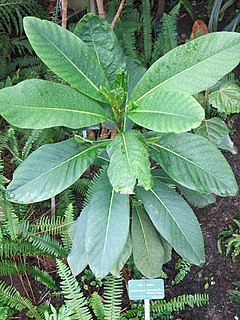
Gardenia is a genus of flowering plants in the coffee family, Rubiaceae, native to the tropical and subtropical regions of Africa, Asia, Madagascar and Pacific Islands, and Australia.

Palaquium is a genus of about 120 species of trees in the family Sapotaceae. Their range is from India across Southeast Asia, Malesia, Papuasia and Australasia, to the western Pacific Islands.

Aeschynanthus is a genus of about 150 species of evergreen subtropical and tropical plants in the family Gesneriaceae. They are usually trailing epiphytes with brightly colored flowers that are pollinated by sunbirds. The genus name comes from a contraction of aischuno and anthos (flower). The common name for some species is "lipstick plant", which comes from the appearance of the developing buds. A full list of the accepted species and their synonyms can be found in the Smithsonian Institution's World Checklist of Gesneriaceae.

Thrixspermum, commonly known as hairseeds or 白点兰属 , is a genus of flowering plants in the family Orchidaceae. Orchids in this genus are epiphytes, lithophytes or terrestrial plants with flat, leathery leaves and short-lived flowers with the sepals and petals more or less similar to each other. The labellum is rigidly fixed to the column and has three lobes. The side lobes are erect and the middle lobe is thick and fleshy. There are about 190 species distributed from tropical and subtropical Asia to the Western Pacific. Most species grow in lowland or tropical rainforests up to an altitude of 1,200 m.

Cynanchum is a genus of about 300 species including some swallowworts, belonging to the family Apocynaceae. The taxon name comes from Greek kynos and anchein, hence the common name for several species is dog-strangling vine. Most species are non-succulent climbers or twiners. There is some evidence of toxicity.

Calanthe, commonly known as Christmas orchids, is a genus of about 220 species of orchids in the family Orchidaceae. They are evergreen or deciduous terrestrial plants with thick roots, small oval pseudobulbs, large corrugated leaves and upright, sometimes arching flowering stems. The sepals and petals are narrow and a similar size to each other and the labellum usually has spreading lobes.

Notylia, abbreviated Ntl in horticultural trade, is a genus of orchids. It consists of 56 recognized species, native to Mexico, Central America, Trinidad and South America.

Vanguerieae is a tribe of flowering plants in the family Rubiaceae and contains about 640 species in 28 genera. It is one of the most species-rich groups within the family and it is distributed all over the Paleotropics.

Fadogia is a genus of flowering plants in the family Rubiaceae. The genera Rytigynia and Fadogia form a strongly supported clade but neither of these genera is monophyletic.

Atractocarpus is a genus of flowering plants in the family Rubiaceae. Its members are commonly known as native gardenias in Australia. The genus name is derived from the Ancient Greek terms atractos "spindle", and karpos "fruit", from the spindle-shaped fruit of the type species.

Cyclophyllum is a genus of flowering plants in the family Rubiaceae. It is found from New Guinea, Australia and on islands in many parts of the Pacific.

Atractocarpus heterophyllus is a species of flowering plant in the family Rubiaceae. The plant is native to southeastern New Caledonia.

Aidia is a genus of flowering plants in the family Rubiaceae. It was described by João de Loureiro in 1790. It has a wide distribution area and occurs in tropical Africa, tropical and subtropical Asia and the western Pacific.

Chiococceae is a tribe of flowering plants in the family Rubiaceae and contains about 233 species in 27 genera. Most representatives occur from southern Florida to tropical and subtropical America, except for the genera Badusa and Bikkia, which are found from the Philippines to the West Pacific, and Morierina and Thiollierea, which are native to New Caledonia.

Pavetteae is a tribe of flowering plants in the family Rubiaceae and contains about 624 species in 9 genera. Its representatives are found from the tropics and subtropics of the Old World and the southern Pacific region.

Gardenieae is a tribe of flowering plants in the family Rubiaceae and contains about 586 species in 53 genera.

Monoon is a genus of plants in the family Annonaceae and the tribe Miliuseae. Species have been recorded from the Indian subcontinent, Indo-China, Malesia, New Guinea and Australia, with introductions in West Africa. A number of species have been moved here from the genus Polyalthia.
















